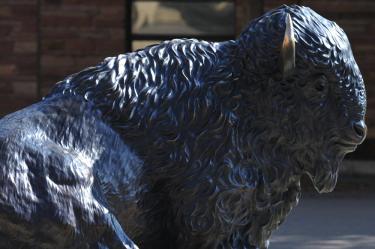Leeds Business Insights Season 2 Episode #4
S2E4: Ovunc Yilmaz - Data-Driven Ticket Pricing Strategies
[00:00:00] Amanda: Welcome to the Leeds Business Insights Podcast, featuring expert analysis to help you stand out from the herd. My name is Amanda Kramer. We are thrilled to be discussing data-driven sports ticket pricing with Ovunc Yilmaz, Assistant Professor of Operations at Leeds. Welcome to the Leeds Business Insights Podcast, Ovunc. And thank you so much for being here today.
[00:00:25] Ovunc: Thank you, Amanda.
[00:00:26] Amanda: All right. Let's start by grounding our listeners in the size of the sports market and ticket revenues. Tell us more.
[00:00:33] Ovunc: Sure. So, in 2019, the North American professional sports market passed $70 (7-0) billion dollars in annual revenues. And the ticket revenues, or what the industry call them, the gate revenues, were almost $20 billion. And they are one of the major revenue sources of this industry, others being media rights, sponsorship, and merchandising. And, of course, this industry has been hit pretty hard by coronavirus. And nowadays, we can say that the sports industry is on a recovery phase.
[00:01:04] Amanda: Still, a huge market. So, let's talk a little bit more about the team side. What does the pricing problem look like? And what processes go into pricing?
[00:01:15] Ovunc: Pricing problem is a very complex one because teams are selling tickets for highly differentiated seats. For football, you can think of 50-yard line seat versus an end zone seat. For basketball, you can think of right behind a team bench, or those nosebleed seats that you can, like, barely follow the game. Teams are also selling tickets for different types of games, based on different opponent strengths, maybe some rivalries, pre-season, regular season, post-season.
And teams are also selling tickets to fans with different taste. You can think of a die-hard fan who has gone to every game since they were five years old or someone who is in town for just a day. There are some differences. Someone may be looking out for tickets for their entire family versus someone who just wants someone like solo evening in a basketball game. People have different budget and different scheduling constraints.
And teams are selling these tickets in different formats. So, they sell single-game tickets. They sell season tickets. Recently, they started to sell some multi-game packages. And as you can see, there are a lot of different dimensions, and this problem is really, really complex. And with the growth of analytics and, of course, the digitization of ticketing, a lot of things are on just phones nowadays, the organization, sports organization, leagues, teams, they try to use this data to make more informed, better pricing decisions and improve their gate revenues.
[00:02:44] Amanda: Let's also ground our listeners in pricing strategy options for teams, such as tiered, variable, etc.
[00:02:52] Ovunc: Yes, I can explain three commonly used strategies for our listeners. The first one is the tier pricing. And this one is also known as scaling the house by the industry. And in this one, the sport organizations offer different categories of seats at different prices. And this has been a very popular strategy in the industry for a long time.
The second one I want to mention is the variable pricing. In this one, sport organizations charge different prices across different games, based on the assumption that some games are just, like, better than others. And a fun fact here, I guess, is that the Colorado Rockies was the first team that implemented variable pricing in the sports industry back in 1997. However, there were some hesitations, and it took a while for the entire sports market like most of the other sports need to adopt this. And for example, the NFL did not even allow the use of variable pricing until 2014. Teams and leagues were just unsure about if this strategy is working or not. And we have a recent paper on this topic that shows that variable pricing surely boosts the primary market sales. We used that data from NFL, and I have some interesting findings.
The third one is dynamic pricing, the new big thing in the sports market. In this one, teams or sports organizations set prices dynamically in real-time. And this is different than variable pricing because, now, you do not only choose different prices for different games but also update your prices continuously based on the demand that you observe. And this sounds like an ideal way to price tickets, maybe academically. However, it's actually quite tricky to implement in real life because of some major problems coming from the fan base. So, for example, if your ticket prices go too high due to the dynamic pricing, fans feel like maybe gouged or exploited and might get unhappy about them. And if the ticket prices go too low, this even might be a problem because think about this season ticket members who pay the set fee at the beginning of the season and think about these single-game ticket buyers sitting next to them paying lower fees. Of course, there might be some negative reaction on that side.
So, these are the three major strategies that I think we need to know. And in addition to these, I think some teams are nowadays also using some ticket auctions while selling their tickets.
[00:05:16] Amanda: So, Ovunc, one thing that might surprise listeners is that there are many factors that impact pricing. We're talking about something as small as whether the sun is hitting the seats or the seats are in the shade. Tell us more about the factors that impact pricing.
[00:05:31] Ovunc: Great points. Ah, so, in this one, I think we established that the problem is really complex, and there are wide array of strategies for teams to use. But how are they going to price their tickets? So, with the help of analytics, both teams now have a much better understanding of their customer base, and they try to utilize the analytics tools to maximize their revenues.
And a lot of factors actually can go into the pricing decisions. In a recent paper, my coaches and I worked with a pretty popular college football team and showed what type of factors may or should influence pricing decisions. And I want to share some insights here for the listeners. So first, fans value seats based on the position, with respect to the field and the distance from the field. These are intuitive. But we show that, actually, they also value seats relative to the position of the sun and video board. Second, the value of seats in a section is often consistent in and around the center of that seat category. However, the value increases or decreases in the pair free, depending on if the seat is bordering a higher or lower price seat section. Third, fans value gates, not only based on the opponent, oh, this is a great opponent or this is a horrible opponent, but also considering the time of the year, especially if the game is way later in the season and there's a potential snow or like really bad weather for them.
So, we show that, actually, this specific team may improve their revenues around 12% if they incorporate all these factors into pricing. And I think this is where the industry is going, like, identifying these factors and implementing pricing strategies that incorporate them.
[00:07:17] Amanda: The average sports enthusiast may not know that there are many owners of tickets. There are also companies that buy and resell tickets. And then, we also have brokers, scalpers, and fans in between. Tell us more about these secondary markets.
[00:07:31] Ovunc: Since the ticket resale is allowed, there exists the secondary market of these tickets after they've been purchased from the primary market. These transactions in this market, the secondary market, may take place between just two friends, like me and you, or in person near the venue, those like kind of old-school scalpers, or through online secondary markets. That's, I think, the most common way nowadays, such as StubHub. And although an average sports fan may think that, like, most of these transactions in this market are just between two fans who happen to own tickets, the secondary market itself is actually now a $15 billion industry dominated by brokers.
And since the sports teams are reluctant to set sky-high prices, we talked about this when I was discussing the dynamic pricing, like a potential public outright they're afraid of, or basically harming their reputations, there's often a big gap between the face value of the tickets in the primary market and what fans are willing to pay. And this leads to openings in the market for what we call brokers who make money from buying and selling tickets. And these brokers are often technologically advanced. So, they use strategies like broadcasting, where they can even hold some of the tickets from the audience until start time of the game. Maybe, they offer tickets like a couple of days in advance. Or, they can use this technology called bots, where they can snap up a large number of tickets from the teams in a couple of seconds when the tickets are online in the primary markets.
[00:09:05] Amanda: We've got these bots out there, Ovunc. Is there anything that we can do to fight them?
[00:09:09] Ovunc: So, yes, these robots are just rapid ticket-buying algorithms that can effectively skip the lines and purchase tickets quicker than fans. It's a major problem in the industry nowadays. For example, there were more than 5 million attempts by bots for Toronto Raptors tickets for the 2019 NBA Finals. And in 2016, the U.S. Congress passed the Better Online Ticket Sales, the BOTS Act, to combat the use of bots by making it illegal to use any form of bots or computer software designed to gain the ticket system.
But I think the primary market should do more on this end. And for example, Ticketmaster introduced this solution called verified fan platform, where each fan who wants access to tickets must register, get verified through some questions, and then receive an invitation to purchase a ticket. AXS has a solution called waiting room, where fans have to wait before the sale begins. And they'd filter out the bots and speculators during that waiting period. However, again, brokers have many avenues. They are making money out of this business, so they can create multiple accounts, use multiple credit cards to pull these tickets. So, I'm not sure if any of these strategies are kind of a foolproof solution to this bot problem.
[00:10:24] Amanda: What about for mega events or events where the location is not known a year in advance or there's uncertainty about whether your team will be in the event, like a playoff period?
[00:10:33] Ovunc: Yes, mega events is a very big industry by itself, because these events greatly differ from regular sports games, as they attract a much bigger fan base and occur less frequently, as we can just see in the Super Bowl example. I break mega events into two categories—those with predetermined locations that allow for years of advanced logistical planning, such as, again, Super Bowl or Olympics, or World Cup, where ticket markets begin months in advance, although teams are often determined in the last couple of weeks. And the second group is those events whose locations are not determined until the qualifying teams are confirmed. And Stanley Cup playoffs Major League Baseball playoffs are other examples, where teams often have only a week to plan everything.
So, although these two categories are different in nature, the leagues or teams often wait until the last minute for distributing the tickets because again, we don't even know the teams. And matching demand and supply in such a short time is not very easy and not actually possible. Plus, we can again think of the secondary market side of things. There's a lot of value lost to the secondary markets because brokers can resell tickets with huge markups. They sometimes even sell tickets they don't even have. And a great example of this is those tickets that were sold from $10,000, $20,000, even $50,000 per seat for the Colorado Avalanche Stanley Cup Finals.
So, I have some work on an idea called ticket options. So, this might actually tackle this supply-demand mismatch. In this idea, customers pay for a reservation or an option, but they only pay for the face value of tickets if their chosen team advances to that stage, for example, the Super Bowl. And this strategy actually has been implemented in the college football semifinals and finals for a while. And we basically showed that it's beneficial for the teams.
[00:12:36] Amanda: Now that we've discussed the strategies and analytic processes that you've studied, we know these work in theory. But what about in real life? What should companies consider as they implement pricing strategies and think about their fan base?
[00:12:48] Ovunc: Yes. So, I think we should look at this problem in two pieces. In the first piece, the teams or sports leagues should understand their customer base. So, what type of customer segments do you have? How much these segments are willing to pay for a given ticket. Digesting this information, combining it with what type of seats they have, what type of games they will play in a given season, they should optimize the prices for their season tickets, single-game tickets, multi-game package, etc., simultaneously.
So, analytics, I think, is really important. And there are a lot of papers in the field of revenue management and pricing, sports economics showing that these methods work. So, this is the science part of it.
However, second part, and this is the art part, though a long-term impact of a pricing decision should be always an important consideration for a business. So, certainly, the businesses should not take a very simple approach. Well, let me just maximize my revenues for this year. They should think for the long-run implications. Why? Because you know that a pricing decision this year might make your fans upset and make you lose a bunch of money in the future. So, teams often employ experienced strategists or people in the box offices when they are making pricing decisions.
And I will give you an example, not directly from the sports market, but this Bruce Springsteen tickets created this big public outcry because Ticketmaster, the primary market seller of the tickets, charged around $5,000 a piece in the primary market for some of the fancy seats there. And fans were really, really upset about this. And this is a great example, even for the sports market, and a good lesson for the sports market. Teams should be very careful while using the innovative analytics strategies because that art component, the pricing as an art component, is really important where some experienced people should actually come into play and make those necessary adjustments to make sure that you will reach your long-term goals rather than your short-term revenue goals.
[00:14:57] Amanda: Every episode, we have an LBIdea or a key takeaway. And the key takeaway here is, although analytics strategies and processes may look great on paper from a science perspective, you always need to consider, as a business, how is this going to resonate with your consumer and land with them? It's that combined art and science that you've been talking about.
[00:15:17] Ovunc: Yes, Amanda, you got it.
[00:15:18] Amanda: Okay. Well, Ovunc, thank you so much for joining us today for the Leeds Business Insights Podcast. It's been a pleasure having you.
[00:15:26] Ovunc: Thank you so much.
[00:15:29] Amanda: Thank you, again, for listening to Leeds Business Insights. Don't miss a single episode. Subscribe to Leeds Business Insights wherever you get your podcasts. You can also find more information about our podcast series at leeds.ly/lbipodcast. We'll see you next time.
The Leeds Business Insights podcast offers a cutting-edge perspective of trending topics, along with actionable insights from faculty, alumni and global leaders, to help you navigate the evolving world of business.
We invite you to subscribe wherever you get your podcasts, read about our latest episodes or listen to the most recent podcast below.







